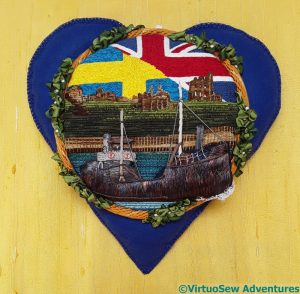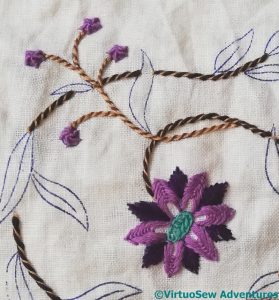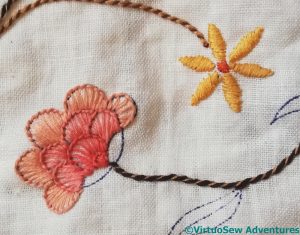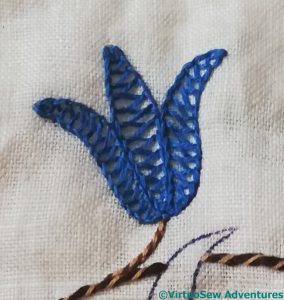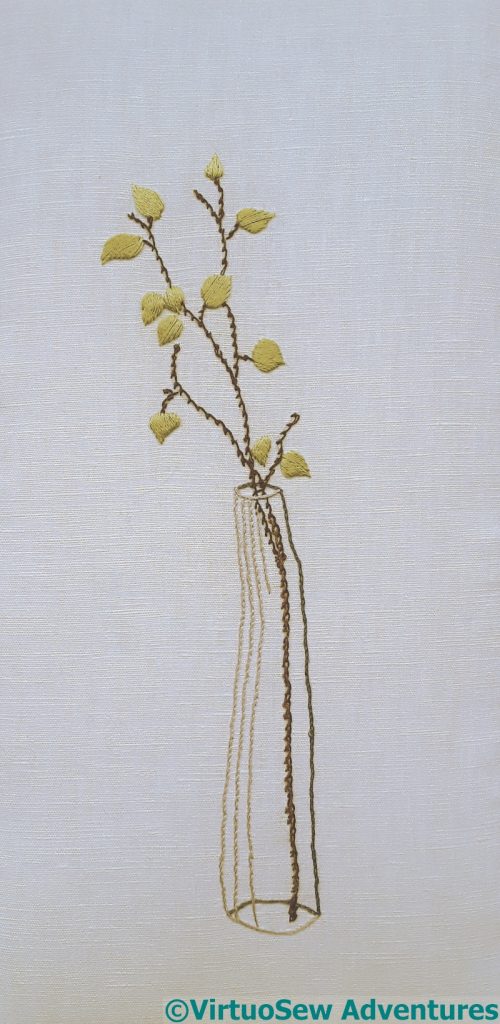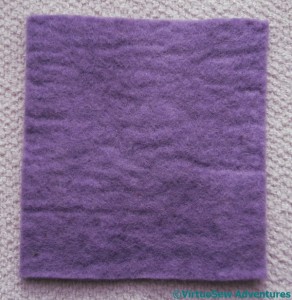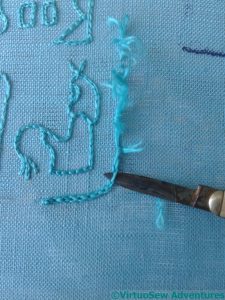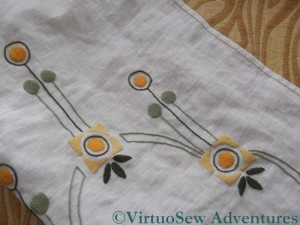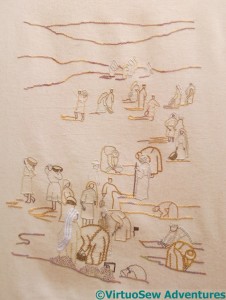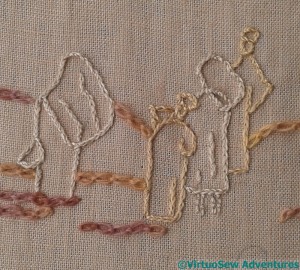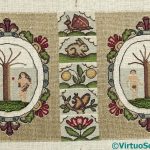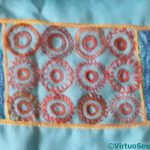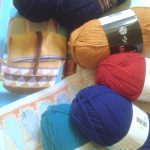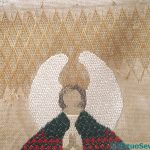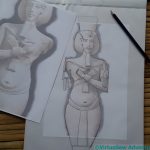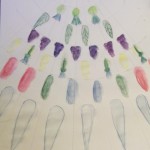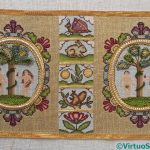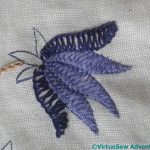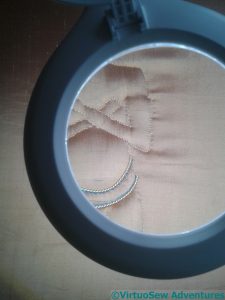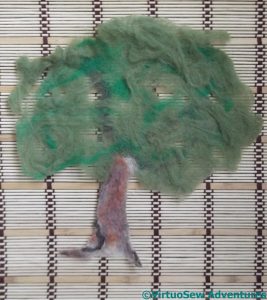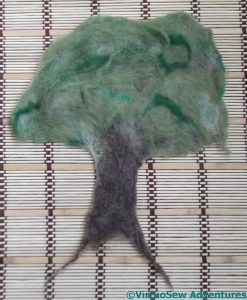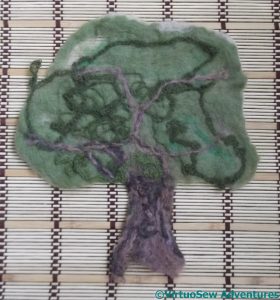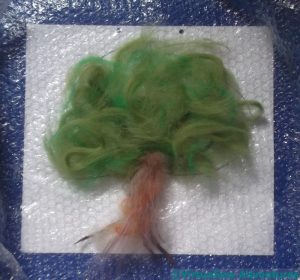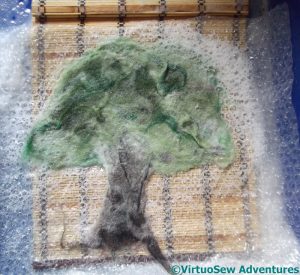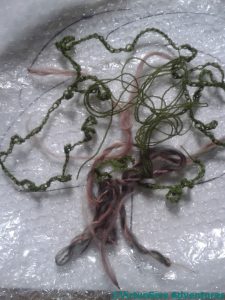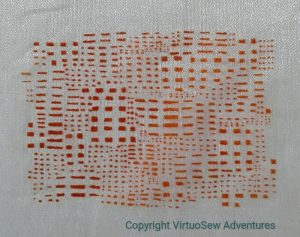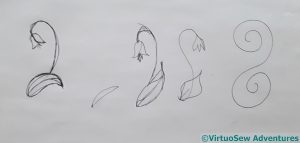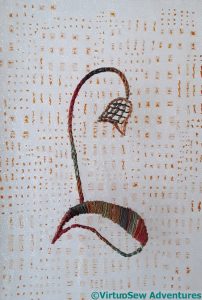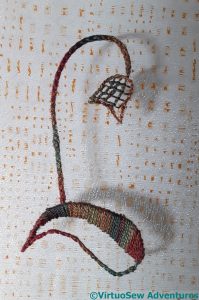Category: General Posts
The LoveCrafts Blogger Awards – #WhyIMake
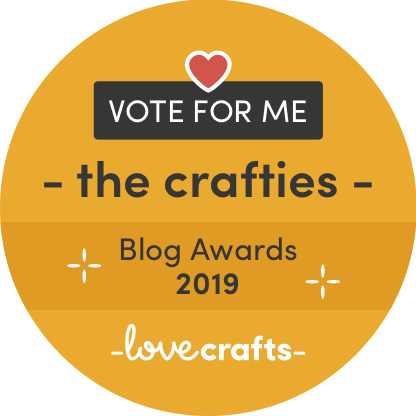
Well, that was a surprise. I’m only vaguely aware of competitions and awards at the best of times, and with a good many things in my offline life distracting me and a good deal of embroidery swirling around in my head, I wasn’t in the least prepared for an email asking whether I would accept a nomination in the LoveCrafts Blogger Awards “Stylish Stitching” category. And having accepted the nomination – just you wait until you see the company I’m keeping! Wow! *cue music: “If they could see me now, that little gang of mine….”*
I suppose I should say “Vote for me!“, and I do, but really, go look at everyone’s blogs, have a rummage, and see more wonderful, delightful ways of using needle and thread to create magic than you ever imagined!
On to #WhyIMake…
Why do I make? To tell stories in stitch. Really, I think it is as simple as that.
Sometimes the story is purely one of delight in fabric or thread or stitch.
The Japanese Crane here was worked purely because I love Hungarian Braided Chain stitch, which I’d just discovered. It’s variation on broad chain stitch, and the intricacies are particularly well suited to showing off the colours in the variegated thread.
Sometimes the stories are much more complicated and emotional.
“Leaving The Tyne, 1915” relates to my Swedish Great Grandfather, and his service as a merchant seaman during the First World War, but elements of the design and stitching, and even the choice of that story to tell, are all part of my own response to the world around me now, the demonising of “migrants” or “others”, who yet contribute very greatly to our life and culture. I don’t think I’m a political person, but in this one, however subtly, I’ve nailed my colours to the mast.
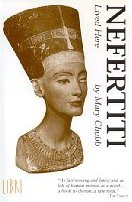
And as for “Dreams of Amarna” project that has been taking my mind for the last ten years, nearly – that’s a response initially to a book I read, called “Nefertiti Lived Here”.
It’s an enchanting book, about a dig in Amarna in the nineteen-twenties, seen through the eyes of the secretary of the dig, who was also a student of sculpture. Her sympathetic imagination peoples the site with ancient Egyptians, and her interest in everyone she met, the local labourers, the Gufti excavators, Museum officials and her colleagues brings life to everything she encounters. My embroideries seek to convey the delight she found there, and that I found in her book.
So, um, yes Vote For Me, please!
State of the Tablecloth – 1
That transfer I’ve been working on wants to be finished, and I’m pretty much at the stage of thinking about the leaves, so just so we all know where it’s up to, I’m doing a State of the Tablecloth post.
So the petals of the purple flower are in nested fly stitches, the centre is a sort of looping interlace, and the little buds are spider’s wheels. I packed the spider’s wheels quite tightly, to raise them up and increase the texture – I know that raised elements on a tablecloth can be a problem, but it’s no problem on the falling part!
The small starflower is the only element that I’ve done as the instructions that came with the tablecloth suggested – satin stitch.
The ruffly flower – do you think it might be a crysanthemum? – seemed a perfect opportunity for buttonhole stitch fans. I might decide to whip the edges to pull out the colour progression a bit more, but we’ll see what the flower wants when the leaves are on.
Double chain stitch is easily confused with closed feather stitch, and in this case I complicated my life considerably because I changed the breadth of the stitch to match the petals of the flower. I rather like the effect, and although I said it was a complication, the actual stitching flowed quite nicely.
And rather than give you a Long Read, look out for episode 2…
Alarms and Excursions!
My hosting provider has had an alarming few days, with their machine going down with no warning. Furthermore, when they came to restore everything affected, they discovered that as part of that failure, the backups had silently failed (which is something we’ve experienced at home, so we sympathise!).
So I have lost all the comments on the most recent post, even the ones I’d already replied to.
If I haven’t replied, I’m not ignoring you, I just haven’t received your comment.
Overcoming The Fear
This post has its roots in some conversations I’ve had with friends who are involved in education and enrichment, and in our mutual realisation that, although we may have different words for it and although we may face it differently, there is an experience we all recognize, and which it is very hard to coach students through.
No matter what you are doing, there is always a point early in a project where you find yourself staring at a blank sheet, wondering where to begin, what to do, and how to approach the challenge. This happens in every field of endeavour, whether it is obviously “creative” in the sense of painting, embroidery, or sculpture, or in a more academic field such as mathematics (The Australian is a mathematician, so I know about these things, even though I’m not one myself). And it isn’t limited to beginners.
You stare at your blank sheet, mind racing – or frozen – completely overwhelmed. Everyone devises their own strategies to overcome this, and the sooner you find your own, the easier your life will be.
The first is to pick something – anything – and try it. I am coming to realise that one of the signs of not being a beginner any more is the willingness to do work which may be abandoned – unpicked, reverse stitched, torn up as leading down a blind alley. Sometimes you have to see What is wrong, and How it is wrong before you can pick the Right Thing.
Another very useful strategy is to create limitations – to lay down rules that limit your choices. The idea is that part of the reason you’re overwhelmed is that with so much you could do, it’s almost impossible to choose which. In mathematical or computing terms, what you need to do is restrict the search space. It might seem paradoxical, but when you restrict your choices it can become very much easier to make progress. So the strategy of making a set of rules, or creating a framework within which to make decisions (to write a sonnet, say, instead of blank verse), can help you get started. Once you’ve got started, you can then decide to break the rules if the effect will be better. The important point is that you’re now over the Fear of Blanks and into the flow of the project.
When I’m working on a new project, I have to make decisions about the design, the fabric, the colours, the threads, and the stitches. Some of those decisions may be made for me. For example, if the project is “domestic” – a table runner, a cushion, the cover for Maggie the Magnifier – then I know where it’s going, and the colours will have to work in the room in question. Or if I’m embroidering a garment I already have, I have no choice about the fabric, and very little choice about the threads. I don’t have to worry about those, and can spend my energy on design and stitch choice.
But in the case of The View of the Excavation, for example, I had the design, but I then spent days – weeks! – staring at it and wondering what stitches and colours to use where.
So finally I devised a series of Rules:
1 – Narrow, plain stitches for distant figures, becoming broader and more textured close to the front;
2 – Pale colours for distant figures, more emphatic colours close to the front;
3 – Ground features in the same colour and stitch wherever they are.
I still had freedom to choose stitches, threads, and colours, but The Rules restricted the range within which I was choosing, and so made the decisions easier. Furthermore, because I’d picked a stitch and thread for ground features, I could get started, and think while I stitched, which meant that as I came to apply my various rules, the blank fabric was already no longer completely blank.
Each of the first two rules could be elaborated further, so for Rule One, I picked two different pale colours to choose between, and chose one stitch to use. Again, the decisions are thereby reduced and thus easier to make, which means that progress can be made while thinking about the next stage.
This is the manifestation in embroidery of one of the reasons that school maths can be dull and repetitive – it is trying to inculcate skills which will allow us to work mechanically on the simple stages or processes of a problem or puzzle, leaving the brain free to tackle to the more complex parts that will require serious, creative, and inventive thought. My sitting quietly working the “easy” bit while I think about my next step is exactly analogous to the mathematician rattling through some calculations while they consider what part of the problem to tackle next, or the writer writing a descriptive section while the back of their mind is busy mulling over the plot.
So next time you’re stuck over something, try this: pull some rules out of thin air and stick to them. Then break them. Thoroughly. And with enthusiasm!
6 and 6 in 2018 – the six “old” projects
This year Meredithe and Anne have come up with the idea of managing “Significant Progress” on six old projects or Works In Slow Progress, with room for six entirely new ones – because we all know how easy it is to be completely knocked for a loop by a shiny new project or sudden obsession with a new technique! – and have called the project “6 and 6 in 2018“. I wasn’t a very organised contributor last year, and I probably won’t be this year, but I do intend to try!
For the sake of accountability, here are my “old” projects:
First of all, “Eve In The Garden of Eden”. This means constructing and covering the box. That in turn implies the use of glue, which as I’ve mentioned before, makes me very nervous indeed. It will probably take some effort to get up the courage to tackle it at all!
Secondly, the Nefertiti Shawl. It’s such a lovely cheerful colour that I want to be able to wear it, which should be incentive enough, wouldn’t you say?
Thirdly, the Amarna Backpack. I’ve made a fair bit of progress here, and I’ve learnt a few useful lessons, but I want it to be useable, and preferably lined, by the middle of the year.
Fourth, the Christmas Angel. It really is simply a matter of getting it set up so it is convenient to tackle this one, but of course in terms of work to be done it has strong competition, from number five.
Fifth, of course, is Akhenaten. I’ve put him away over Christmas and missed him terribly, so I have a strong feeling that he’s going to send the rest of them to a distant second place!
Sixth isn’t really a single project, but rather the crystallisation of ideas which are already bubbling in my head, like the Faience Necklace, and the beginnings of ideas for the Vision of Placidus. There are some that need to be out on paper for the next stage of mulling over. Anything that helps with that will make this year a huge creative success!
Round-up for 17 in 2017
I have had a look at my progress on the projects I listed for the challenge run last year by Meredithe (Pomegranate and Chintz) and Anne (Frayed At The Edge) – 17 UFOs in 2017.
In most cases, I didn’t even look at the projects, in spite of my very best efforts. In my defense, when I made the list, the projects for the Head of Nefertiti, Akhenaten, and my two little Amarna Princesses hadn’t even occurred to me, and they completely distracted me! Their project for this year – “6 and 6 in 2018” takes this possibility into account, allowing for reports on six old, or at least long-running, projects, and six brand new ones which pop up out of nowhere. I can’t be the only one who gets completely taken over by new ideas!
So, here’s the round up…
1 Eve in the Garden of Eden – all I need to do here (all!!!) is to make the box. At the moment the fabric is pinned out to straighten it a bit. I think I can call this “substantial progress”!
2 Nefertiti Shawl – I’ve recently written about the headache that this has given me. I need to get all my silks out again, and think hard about the next stage. I think I may have the faintest hint of an idea for it, but as I say, that needs much more thought.
3 Queen Anne style teacloth – I got something done on this when we had a bit of a heatwave, and I’ve worked out the stitches for the Blue Flower. I just haven’t done all of them yet. “Progress”, but not “substantial progress”, I think!
4 The Modern Stitch-Off – I think I will decide that this is finished, but I reserve the right to change my mind!
5 The Christmas Angel – I made a good start on the background, but there is a good deal more to do – again, “Progress”, but not “substantial progress”.
6 The Faience Necklace – I’ve thought about it, but done nothing…
7 The Swan – not a stitch!
8 The Unicorn – not a stitch!
I think it is fair to say that since I was ambushed by some wildly exciting ideas, it’s scarcely surprising that my attempts to finish other projects fell somewhat by the wayside. It was a nice idea, and I’m glad that Meredithe and Anne came up with it, but we none of us allowed for my wayward spirit of invention!
Thoughts on my new working light
My primary purchase at Harrogate was a new, floor-standing working light. I’m hoping it will make a difference to working during the poor light of winter, since otherwise whole days go by when it is too dark to embroider.
First of all, if you’re thinking of getting one, think as hard as you can beforehand about what you want it to accomplish and when you will use it. Then if you can possibly go somewhere to meet your potential lights, do so. The technology has been changing a great deal, and there are several varieties on offer. The advantage of doing this at Harrogate was that The Craftlight Company had a whole stand of different types of light, and several people available to talk to.
My choice has now arrived, and I have to say that the early signs are good. The reach of the light from the source is much better than on my old desk-lamp type working light, which would be fine for a desk based form of craft but isn’t so good for embroidering at a floor standing frame or even in an armchair. It was easy to set up, and I’m beginning to learn what adjustments have the better effect. Since the lights are set around a magnifier, I have the option of using it as a standard lamp or as an illuminated magnifier, and I’ve yet to settle on my preferred option.
All this is being complicated by the fact that I have a new prescription for my embroidering glasses!
I do, however, offer one warning – apparently the light is also good for sufferers from SAD. I remember reading once that such lights are most beneficial when used at particular times of day. It’s certainly a very “wake-up” sort of light, and I’ve come to the conclusion that I’d better not use it after dinner, because the one time I did, I was awake for hours longer than I wanted to be!
Some early (very early!) experiments for the Vision Of Placidus – Part Two
Once everything had dried, I could sit back and look at my trees.
This is the first one I did. It used some multicoloured merino in the trunk, and two greens from the beginners felting kit I bought on eBay a while back. They’re not very nice greens, but all I’m doing is investigating the technique.
There are only two or three layers of wool in this one, which means there are gaps in the felt, and the junction of the trunk and the canopy is a bit flimsy. Gaps in the felt for the canopy are no problem at all – they would help to add depth to the finished piece. Since everything will be caught down (somehow – I don’t yet know how!), strong, dense felt isn’t really the aim here.
The second experiment had the addition of some short staple (that is, short fibre length), very crinkly wool. I was hoping it would result in greater shrinkage, which it has a little. It also produced a greater variety of shades in the canopy, lightening and interrupting that rather dull green. This may have promise, and the felt itself seems a little more stable and would be easier to stitch into.
Since the fibres are rubbed and soaped and rolled, and generally beaten up, it’s not surprising that the effects of trying to place the fibre colours to create a particular appearance is, to put it mildly, an inexact science. I wonder whether I could combine needle-felting with wet-felting to make the results more controllable?
In the final experiment, I added crocheted chains and some tangles of yarn as well. Some parts of the chain didn’t felt in quite as well as I might have hoped, but with more crocheted chain and a better understanding of how to felt it in more thoroughly, it might produce a very good effect.
My semi-spun yarn on the trunk has worked, though, and looks even better in real life, although, again, what it needs is the courage of my convictions and rather more of the same.
So, not a completely unsuccessful experiment, and certainly a good basis for further experiments, perhaps with added stitching…
Some early (very early!) experiments for the Vision Of Placidus – Part One
I’ve been struggling with a sore and stiff shoulder for some months now. It’s made me reluctant to go back to Eve In The Garden of Eden because at this stage she demands perseverance in a single, small stitch for the gold groundwork. The Head of Nefertiti has involved more variety, and earlier signs of progress, while the canvaswork is perfect for evenings.
However, my shoulder is beginning to ease and I’m feeling more willing to experiment. So I had a very entertaining morning last week (it was on Instagram and Twitter) having a go at something I saw on someone’s blog a few months ago and thought might have possibilities for the underlayer of my planned Vision of Placidus panel. If what you see looks familiar, please let me know and I will gladly edit the post to give credit!
Now, the Placidus panel is going to be about five foot by four foot, so even using some of the chunky threads I am happy to use (… and may even spin for the purpose!), it will take quite some effort to cover it. So I thought maybe I could wet felt some rough elements – trees, rocks, clouds, the stream, which could then be applied and tweaked, improved and generally titivated with stitchery.
In the absence of a real – waterproofed! – studio, therefore, I was to be found squatting on the kitchen floor, using a Lakeland Limited tray for cleaning oven shelves to contain the splashes and soap. I must have looked distinctly odd, but I’m accustomed to that!
In the case of the final experiment ( I did three), I rummaged for some fine crewel wool and made a crochet chain, with some very slapdash and freeform loops added in, and laid that down first, with a tangle of leftover yarn.
I also fished out my spindle and had a go at spinning and doubling some wool to create a different effect on the trunk. That didn’t work too well – the yarn kept unspinning itself. My shoulder isn’t up to a concerted attempt to crack spinning, so I made do with what I’d got, and backed it with various other wools to hold it together.
At this point – creaking slightly in the lower back – I decided to stop, rinse everything off, and let my trees dry before going any further. .
Shadow Play
I decided, as I stared at the printing of this blocky pattern onto gauze, that I wanted to use the transparency of the gauze as part of the finished effect.
I don’t have a destination in mind for this piece which will give me a theme, so I decided that, in order to highlight that one quality, I would use a single thread (as it happened, a variegated silk), and design a fragment that would allow me to experiment with the effect of stitch cover and openness.
I leafed through books about pattern, saw nothing that gave me the combination I wanted, and then evolved the fragmentary organic sketch on the far left to give me the balance of line and form I was looking for. Incidentally, this is quite possibly the swiftest and shortest progression of any sketched design I’ve ever come up with!
It’s astonishingly difficult to trace a design onto a fabric which is essentially invisible, and still harder, I might add, to follow the lines when you have finally put them there!
I used Hungarian Braided Chain Stitch for the stem, satin stitch for the solid side of the leaf, and Jacobean trellis for the flower-head. Clearly that gives me a solid coverage, and a firm line; I was hoping that the Jacobean trellis might offer a sort of half-shade.
A qualified success, I’d say. The printed pattern doesn’t create a shadow, and the Jacobean trellis shadow isn’t a sort of half-depth.
But, my goodness, the shadow of the stem and the leaf work exactly as I hoped! The gauze itself almost disappears, leaving the printed pattern floating above the surface, and the leaf and flower thrown forward by their shadows.


